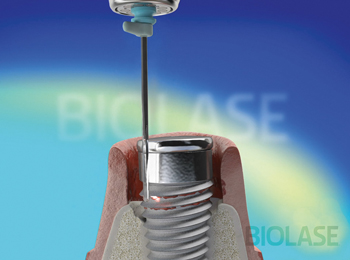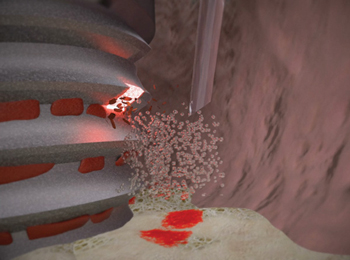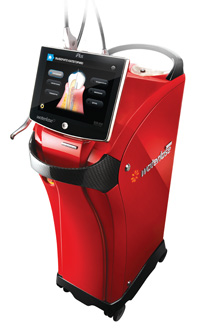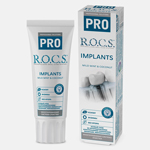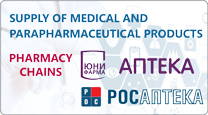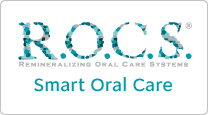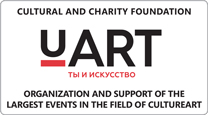17 November 2021
Peri-implantitis. Laser. Waterlase

YAROSLAV FILATOV
Dentist, general practitioner, surgeon, orthopedist, implantologist,
chief physician of the Laser Smile clinic, Samara
|
The laser
came to Russian dentistry in the early 2000s and today is no longer perceived
as something revolutionary. It has become the standard for quality dental care,
for which there are proven protocols and methods. Today we are talking about
the protocol for the treatment of peri-implantitis.
CAUSES
Peri-implantitis is an infectious inflammation of the soft
and hard tissues in the area of a dental implant. The source of inflammation is
the pathogenic microflora on the surface of the implant, which causes
resorption of bone tissue around the implant, it loses bone support. In case of
peri-implantitis pathogenic microflora releases toxins, which harms the
biological environment — soft and hard tissues — everything that surrounds the
implant. Inflammation occurs, which causes severe tissue
damage.
The main causes of the disease are poor hygienic care of
teeth and implants, high consumption of sugars in food, bad habits (smoking,
bruxism — clenching of teeth), lack of control over the implant by a
doctor.
FORECASTS
Today, implantology is one of the most popular dental area.
Considering that in recent years a huge number of implants have been installed
in the world, effective and modern therapy of peri-implantitis as a disease is
an important and urgent problem in dentistry.
The American Academy of Implant Dentistry estimates that
about 3 million Americans have implants, an increase of 500,000 annually in the
United States alone. Unfortunately, this means that the incidence of this
disease is steadily increasing.
SOLUTION
For a long time, dentists could not find a solution to how
to deal with the pathogenic flora on the surface of the implant. Microorganisms
are so tightly adjusted to the surface of the implant that it was impossible to
remove them without damaging the implant. With the advent of laser
technologies, it became clear that at certain power parameters, laser radiation
does not affect the titanium surface and, at the same time, very effectively
removes the microflora — it decontaminates the implant surface.
In this case, biological tissues, absorbing laser radiation,
receive powerful biostimulation, which improves cell regeneration in the
postoperative period.
TREATMENT
PROTOCOL
The REPAIR Implant™ protocol is the leading scientific method in the
treatment of peri-implantitis. Using the Waterlase® hydrokinetic laser and
patented Radial Firing Perio Tips™ (RFPT) and Side Firing Tips™ (SFT) with
REPAIR Implant™ provides a safe and effective laser treatment protocol.
Stages of the treatment
protocol
Stage 1. Preoperative. The patient
undergoes a comprehensive examination, a detailed history is collected. The
doctor's task at the first stage is to assess the state of oral hygiene, the
degree of the disease and the risks of treatment.
At this stage, professional oral hygiene is carried out, special attention
is paid to the removal of dental plaque from the crown and abutment. If
necessary, the superstructure is modified to eliminate the biomechanical
overload of the implant.
Stage 2. Surgical. During this stage, the following
steps are carried out:
 |
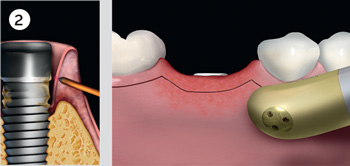 |
|
1) deepithelialization of the outer walls of the
pockets (the gum epithelium of the outer pocket is removed from the free
edge of the gum to a width at least equal to the depth of the pocket);
|
2) gingivectomy, if necessary (gingivectomy should only
be performed in the presence of a false pocket. Make sure you don't damage the
gums with a good fit);
|
 |
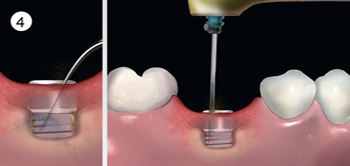 |
|
3) surgical debridement of the pocket (the epithelium
should be removed and completed apically, from the free edge of the gum to the
level of the bone tissue. All granulation tissue is removed. The free edge of
the gum can be folded back like a mini-flap to provide access);
|
4) decontamination of the implant (in the presence of a
large volume of mineralized dental deposits, they are removed using ultrasound.
Use implant-safe tips);
|
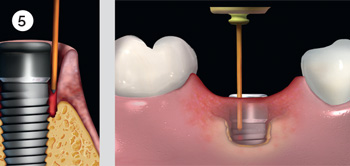 |
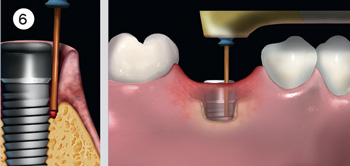 |
|
5) decortication (restore the contours of bone defects
and stimulate bone regeneration. While keeping the tip parallel to the implant
surface, gently tap down on the bone, pulling the instrument slightly backwards
and repeating all movements around the implant. If necessary, change the angle
of inclination of the laser tip and process the walls of intraosseous
defects);
|
6) surgical debridement of the pocket (remove residual organic matter
in the wound and cause blood clotting);
|
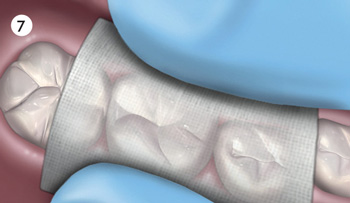 |
7) the operation ends with the imposition of a wet gauze compress on
the surgical site for 3−5 minutes.
|
|
|
Surgical treatment is carried out using a special new
side-scatter laser light guide (SFT) Waterlase. Laser energy gently removes
necrotic tissue, infection, anaerobes from the implant surface and surrounding
periodontal structures. The new light guide is ideal for safe and effective
disinfection. Its 180° rotary handle and unique tapered design provide more
flexibility for treating infected subgingival implant surfaces without flap
retraction.
Stage 3. Postoperative. This period
includes careful care of the teeth and interdental spaces, while the site of
the operation is treated by the patient carefully and sparingly. For three
months after the operation, it is not recommended to carry out drainage in the
area of intervention.
At the moment of development of modern dentistry, the
REPAIR™ protocol using the SFT light guide is an innovative solution for the
treatment of all forms of peri-implantitis.
WATERLASE TIP
FOR SIDE SURFACING
The Waterlase Side Firing Tip is ideal for
safe and efficient processing of the implant thread and is superior to
traditional implant processing methods.
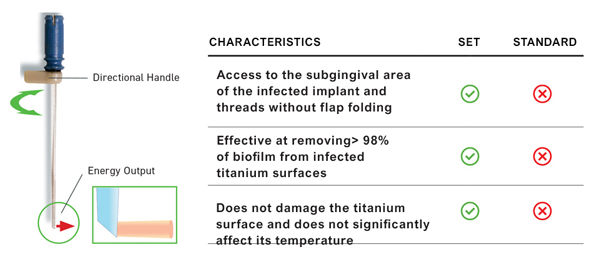
|
LASER EFFICIENCY
Excellent clinical results in the treatment of
peri-implantitis have shown that the laser allows to achieve high efficiency of
treatment, providing a reduction in surgical trauma and high-quality
disinfection during the intervention. Treatment is carried out on an outpatient
basis, without stress for the patient and discomfort associated with
restrictions in food intake and lifestyle. It is important that the use of
technology and protocol minimizes the likelihood of postoperative complications
and shortens the treatment time.
ADVANTAGES OF
USING A WATERLASE® LASER
- Minimally invasive
method
- Easy access to the implant surface and
threads without flap folding
- Treat specific areas or the entire oral
cavity for more flexibility in treatment planning
- Confirmed by clinical data and scientific
research
- The versatile YSGG laser is ideal for complex
clinical use
- Photoacoustic properties of the laser
effectively clean the implant surface
|
7 December 2021
Modern R.O.C.S. toothpaste PRO Implants belongs to the group of professional, specialized products for effective oral hygiene for various orthodontic, prosthetic and other intraoral structures (including implants, crowns and veneers). These constructions make it very difficult to clean the teeth comprehensively, which can cause gum inflammation, cavities, etc.
8 November 2021
As you know, the greatest business benefit comes from a patient who does not leave you forever. Successful clinics earn up to 80% of their revenue on return visits. The base of repeat patients is a huge resource, and experts say that millions are buried in it, but is it so easy to dig them up?
5 October 2021
The chain of family dental clinics BrainMark Dental Studio from the UNIDENT group of companies was launched in Moscow just over a year ago, under conditions of restrictions and quarantine measures. And in just a year, all four centers of the chain achieved results that some clinics have been going for decades.
29 September 2021
Carestream Dental, USA, is a world-renowned manufacturer of dental and medical imaging systems, diagnostics and IT solutions. Carestream Dental's innovative digital lines of systems and software make the work of dentists around the world more efficient and easier - this is both the mission and the value of the company.
27 September 2021
At the very beginning of the pandemic of the novel coronavirus infection, during the period of severe restrictions, the dentist remained one of the most in-demand doctors, especially for pediatric dentists. A team of specialists from Volgograd State Medical University under the leadership of Doctor of Medical Sciences, Professor Irina Valerievna Fomenko analyzed what dental complaints and pathologies they had to face during the lockdown.
Back


